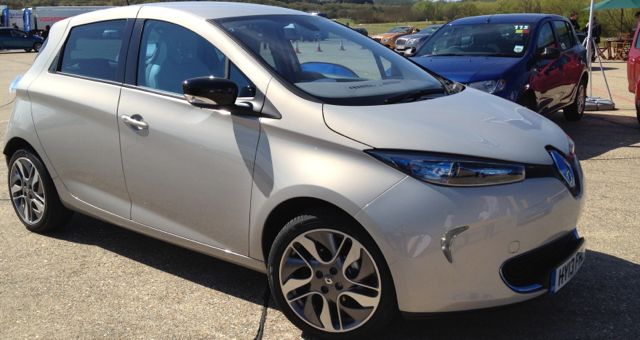 We have been told for quite some time now that electric cars are the future of motoring and the saviour of the polar ice cubes. But just how many electric cars have you seen on the road? One? Maybe three? The Nissan LEAF made a promising start to the mass market of the electric car sector, but there are two big drawbacks that outweigh an electric cars advantages. Firstly there is an issue with range anxiety, and then there is the price. Renault feel they have something that can step up to mark and become the leading electric car model.
We have been told for quite some time now that electric cars are the future of motoring and the saviour of the polar ice cubes. But just how many electric cars have you seen on the road? One? Maybe three? The Nissan LEAF made a promising start to the mass market of the electric car sector, but there are two big drawbacks that outweigh an electric cars advantages. Firstly there is an issue with range anxiety, and then there is the price. Renault feel they have something that can step up to mark and become the leading electric car model.
World meet Zoe, Zoe meet the world. The long anticipated wait for this car to hit the roads is now over as this little EV comes to light. The Zoe is based upon the same platform as the new Renault Clio, no bad thing, and provides buyers with a funky supermini with all of the subtle neat design elements you might find on one of Apple’s products. This car is capable of a 130 mile range (169MPGe) and thanks to its plucky little 87BHP electric motor, it will get you from 0-62MPH in 13.5 seconds. Not too bad considering all of that battery weight it has to carry.
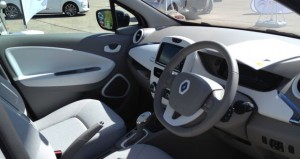
Inside the clean styling is continued with a light interior and big windows. The console is logically garnished with controls and also houses the cars touchscreen interface. Sat-nav, stereo and in-car apps can all be accessed from from this monitor. Renault’s little urban worrier seats five and thanks to its packaging of the battery, has plenty of interior space and a decent sized boot. The seats themselves are comfortable and though rear passengers do sit quite high, head and leg room are par for the class.
As with any 100% electric car, start-up is silent but the Zoe does emit an artificial noise as it goes along to warn pedestrians that aren’t too keen on looking where they are going. The sound is customisable but we found the one that sounds a bit like Marty McFly’s hoverboard to be most amusing. The instant torque an electric motor provides is very intoxicating as upon the exit of a corner you can really slingshot the car out of it. There is a fair amount of body roll in tight corners but the trade off is a ride that isn’t too firm. Road noise at higher speeds is a little more than you would like on a long motorway journey but whilst the Zoe may have a top speed of 84MPH, the city and everyday commuting is where it belongs. The steering is very light and the breaks with their energy recovery system do a very good job of stopping the car in a hurry. The overall driving experience is pleasant and comfortable with the biggest compliment having to be that it feels like a normal car.
The Renault Zoe can be had for just £13,650 after government grants making it very affordable and competitively priced with similar diesel powered cars. Our test car was in top specification which included parking sensors, hands free key card, premium audio system, 16” alloy wheels and automatic wipers. Those toys brings out total for our car to £16,350 as tested, which if you think about it is still very well priced.
The Zoe is clearly a good car, and with a price point similar to its combustion counterparts, it is in prime position to compete for sales. However, Renault will ask a £70 a month fee for the lease of the cars battery, something not every buyer will be too pleased about. That said, if any thing were to go wrong with the battery at any point in the cars life Renault will replace it free of charge.
So there you have it, the Renault Zoe. Stylish, environmentally contentious and affordable.
The Renault Clio is the bread and butter of the French companies model range and with the industry going through tough times in Europe, this cars sales are more important than ever. This is the all-new Renault Clio 4, a chic new interpretation of a car that has sold in vast numbers in previous generations. The 2013 incarnation sports a bold new design that shouts from the rooftops “Va Va Voom is back!” It is bold and aims to reinvent the brand. The car it replaces was conservative in design, but Renault are keen to promote a premium product in the 4th generation Clio and so blending into the class was not on the agenda.
Visually it looks every bit as modern as it claims to be, bringing a little bit of French design to the roads. There is no longer a three door body style for the Clio but by hiding the rear door handles Renault have managed to give the hatchback an almost coupe appearance. It sits lower to the road and is wider than its predecessor making for an object that does turn heads when out and about. The gloss black skirting is also a nice unique design feature for a car in this class. Renault have put a big emphasis on making this new Clio “your own” with a wide range of customisation options including external sticker designs, new interior coloured trim and a range of alloy wheels to choose from at not extra cost.
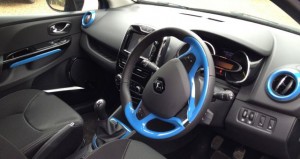
The interior has taken a real step forwards in terms of architecture and quality. Our 0.9 litre Dynamique MediaNav TCe 90 test car was trimmed with some very good looking piano black plastics and was dominated by the cars new touch screen media system. The system housed inside the console allows for easy access to the radio, satellite navigation and BlueTooth settings. The blue trimmed cabin is very well engineered in terms of ergonomics with a comfortable seating positions and a steering wheel that fits very nicely to the hand. Air conditioning controls were in easy to reach positions and are highlighted with neat LED lighting as they are adjusted. Also finding a home within the cars interior are the new Bass Reflex speakers that allow for high levels of clarity even at antisocial levels of volume. It is clear that Renault have packed the Clio 4 with tech and as a result the interior of the car is a very pleasant place to be.
On the road this particular Clio does struggle in some areas. Its turbocharged petrol engine may produce 90BHP but it has to be worked very hard to get the most out of it. All of the power is right at the top of the rev range and though its turbo produces very little lag, it does become little tiresome having to work the gearbox so comprehensively to go anywhere quick. The Clio’s merits lay within its chassis and suspension. The ride is very smooth even on the UK’s battered tarmac surface and the responsiveness when you want to change the cars direction is most welcome. There is a notable amount of body roll when cornering at speed and the steering doesn’t offer too much in the way of driver feedback, that said the cars breaks are very good.
This TCe 90 is good for 62MPG and emits just 104g/km of CO2. I personally think this specific Clio’s problem is the three cylinder engine under the bonnet. It ticks all of the boxes as far as looking after the environment is concerned but when you just want this car to be a revvy little petrol hatchback you can take onto B-roads and just throw into corners the unit provides very little enthusiasm. I genuinely like the brand new car very much with its high quality finishes and curvaceous looks, but I was rather hoping that this pint-sized petrol engine would behave more like an excited Jack Russell.
As an everyday car the 2013 Renault Clio has what it takes to compete with the top of its class, and with the best Euro NCAP results, family buyers should take note. However, the diesel engine is the pick of the bunch.
When the Renault Clio 3 was released, there was an almost audible thud that resonated across the country as every motoring journalist across the country dropped their A5 notepad to the table and thought “here we go again, another bland Clio”. The Clio 3 wasn’t a very adventurous, so you can imagine the tense looks on the faces of the motoring press as the new model was unveiled.
Sufficed to say the new Clio 4 is an excellent piece of engineering. They’ve put it on a diet and made it 45mm lower, 100kg lighter and widened it out a bit. A tuned chassis means the cabin is now almost silent apart from the soft clunk of the excellent new gearbox which allows for faster and smoother gear changes than the previous instalment. The model I drove was the 1.5 dCi which boots out 90 horsepower and 220nm torque. All this amounts to a top speed of 112 and it’ll politely dash to 62 in 11.7 seconds.
Economy in this model is excellent and if you’re driving downhill in 5th gear at 2000 revs with a tailwind, you’ll be reaching the dizzying heights of 88mpg but around town you can expect a more down to earth 70mpg. As with most small diesel hatchbacks these days the emissions are 90g/km which plonks it firmly in the ‘A’ tax band. This new Clio is also very spacious and I could fit all 6 foot 5 inches of me into the back with enough headroom and even with the seat all the way back in the front you could fit a child or a small adult behind me. Way in the back the large boot is big enough for a large family shop with room to spare.
Renault is never the first company I come to when talking about interior quality, but this new model left me lost for words. I drove the Dynamique spec and the inside was excellent, awash with piano black and high quality plastics with a very comfortable leather gear knob and matching half-leather steering wheel. Clear digital dials and the responsive R-Link Touchscreen Media/Navigation system makes the cockpit a very pleasant place to be. Renault have also overhauled the sound system making use of the latest Arkamys 3D Sounds technology coupled with a new 30L subwoofer and high quality tweeters. This equates to no distortion even at the highest of volumes.
There is no denying that Renault have done wonders with this new Clio by comparison to the previous model, thanks of new designer Laurens Van Der Acker who’s brief is simply to “make beautiful cars”. The exterior of this car really is head-turningly pleasant and with added features like extra-tinted rear windows this is a great family hatchback on a budget. What Renault have done here most of all though is given Ford something to worry about, and that’s not too easy to do in the hatchback market. With prices starting at £10,995 for the most spartan model, the Expression and up to £14,995 for the tres belle Dynamique S, this little car is competitively priced as well. Renault will also be bringing two sport models with the GT-Line tCe120 and Clio-Sport 200. These new sport models will definitely be biting at the ankles of the likes of the Ford Fiesta ST and Vauxhall Corsa VXR. The big question is, have Renault finally made a Clio to rival its competitors? And the answer is a yes.
What will be powering our cars in the future? That is the million dollar question to not only automotive giants, but also to everyday folks like you and me. Will we still be pouring petrol into our conveyances in 10, 20, 30 years time? Will it be hydrogen? Electric? Many questions but I’m sorry to say that nobody, not even the “experts” have the answers at the moment. The electric car is something that is very slowly trickling onto the roads with adopters boasting of low fuel costs and virtually no maintenance. However, we are all too aware of these machines drawbacks or else you would own one now. Renault say they have overcome many of the obstacles that stop people from going down the zero emissions root with their new Fluence.
Ok, so lets say that the French company have overcome some barriers that stops people from buying these specific cars, but there is no denying that they have put up another. The Fluence is by no means a looker. I would actually describe its appearance as one of the most uninspiring pieces of design on sale today. Come on Renault! What happened here? Did your designers just run out of enthusiasm after producing some attractive hatchbacks? Let’s put looking like a monkfish aside for a moment and concentrate on why Renault think this car is something special. This is the first full sized all electric saloon you can go out and buy on the UK market. Utilising many of the Nissan Leaf’s internals, the Fluence is off to a relatively promising start. It is based upon the Megane saloon that does not appear in our showrooms and as a result it offers exactly what you would expect from any other car in this segment. Inside you are greeted by a familiar dashboard with built-in satellite navigation. The seats are comfortable and accompanied by plenty of leg room for both front and rear passengers. All of the tangible elements of the car do appear to be genuinely functional just like a petrol or diesel saloon, but now you can ferry the kids to school feeling good about saving the polar ice cubes. The only real downside on the ergonomic front is that the boots capacity is limited by the necessary amount of batteries stored in it.
Out on the road the Renault Fluence Z.E. is actually a very pleasant place to be. The quiet in the cabin, thanks to not having a combustion engine, makes the whole driving experience rather relaxing. As you sink that little bit deeper into the well designed seating you also appreciate the brilliantly soft ride of the car. The suspension soaks up bumps in the tarmac like a sponge does water further promoting the car as an ideal candidate fro British roads. The steering is light meaning that threading the Fluence through congested towns is effortless. What does disrupt the harmonious way it moves about is when you need to slow down. Due to regenerative systems in the brakes, using them often leads to harsh motions whilst stopping. Personally I feel the harvesting of the energy is a little too aggressive and upsets the rhythm that is otherwise enjoyable. Being powered by an electric motor means that there is no waiting for all that torque to kick in. Though the Fluence has a 0-62MPH time of over 13 seconds, it does feel nippy off of the line. 84MPH is its top speed, which isn’t fantastic, but on public roads it is more than enough to get you into trouble, but most importantly it means that it can hold its own on motorways. But just how far will you be going on said motorways? Well, Renault recon 106 miles but our test car didn’t push much past 80. It would appear that range anxiety is still the limiting factor with electric cars.
In spite of not being able to travel as far as a conventional car, this Renault is at least much cheaper to run. Pennies as opposed to pounds charge the car, but with a 12 hour wait from empty to full via the mains, you might want to think about purchasing a book or two. A charging station can be fitted to your house that shortens this time to 6 hours.
This next item I am to bring up may be a real deal breaker for prospective buyers. The batteries in your car will never actually belong to you. Rent is payed to Renault, £76 per month, for the cells that sit in the boot. Obviously this will not please everyone but it does allow for two benefits to emerge. Firstly the risk of adopting this new technology is greatly reduced as if the battery pack breaks then Renault will replace it for free. Also not purchasing the batteries outright results in our top spec Fluence only costs £18,495 with the help of a government grant. Nissans’ leaf costs a few thousand more and realistically you get less car for your money.
Overall the Renault Fluence Z.E. is a step in the right direction for electric cars and brings the class much closer to competing with everyday models. That said, if electric is the future, it still has a long way to go before everyone will be comfortable buying one.
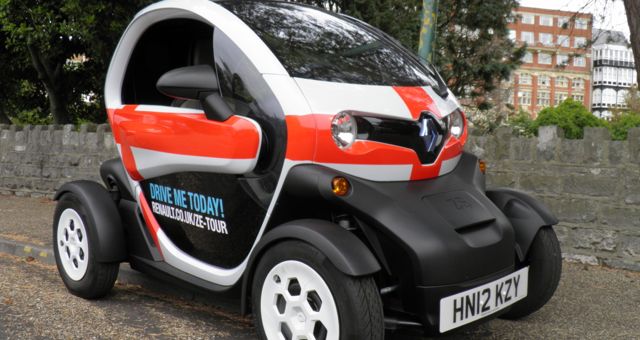 The world is a very congested place. Over population overwhelms the planet as a whole but even in major cities you can see the effects of so many people coexisting in such confined environments. Traffic is probably the most visible example of this and in a bid to combat the amount of cars entering major areas governments the world over are introducing deterrents to get us out of four wheeled personal comfort and onto public transport. Not an enticing proposition by anyones standards, particularly if you are use to all of the creature comforts your modern motor offers. To bypass the never ending attack on motorists by the government you have to think outside of the box. That is exactly what Renault has done with the Twizy.
The world is a very congested place. Over population overwhelms the planet as a whole but even in major cities you can see the effects of so many people coexisting in such confined environments. Traffic is probably the most visible example of this and in a bid to combat the amount of cars entering major areas governments the world over are introducing deterrents to get us out of four wheeled personal comfort and onto public transport. Not an enticing proposition by anyones standards, particularly if you are use to all of the creature comforts your modern motor offers. To bypass the never ending attack on motorists by the government you have to think outside of the box. That is exactly what Renault has done with the Twizy.
It’s an unusual looking machine, I will give you that. Sat on an everyday street it does look like a concept car that has got a little bit lost on the way to a motor show. The Twizy isn’t technically a car at all. It is classed as a quadricycle and in tandem with an electric motor sidesteps the vast majority of reasons you would be forced out of your car in a crowded city. It is very small with a length of only 2.3M. This makes it easy to park even in the smallest of spaces that would allude little hatchbacks. It produces zero emissions and so does not have to pay the congestion charge in London. Also thanks to its electric motor running costs are very low even in start/stop traffic. This all sounds great on paper, but what is the Twizzy actually like in the flesh?
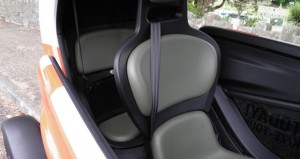
Its futuristic design amounts to something that turns a lot of heads with many people asking exactly what it is. Seating two in single file the interior is spartan to say the least. Radio, satellite navigation, climate control and even power steering is absent in a bid so save weight. The doors are a an optional extra at £550! What you get is a waterproof cabin that occupies two with enough storage capacity for a coat. This ultimately rules the Twizy out for everyday trips and in this country, at least, restricts it to a short daily commute. Clearly at this point you can see that the car isn’t for everyone, but what does it offer those who need such a machine?
The cabin actually isn’t too dissimilar in visual appearance to a car. You get a proper steering wheel, digital display for speed and range, normal pedals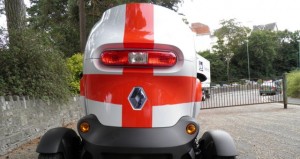 and everybody gets a seatbelt. Sitting in a central driving position allows for fantastic judgment of where the car is around you. This again makes parking effortless and whilst in motion actually is a contributing factor as to why the Twizy is good fun to drive. The electric motor may only produce 17BHP but thanks to the instant torque that comes with it, acceleration is actually very brisk. I found myself charging from junctions like a scolded cat and chuckling to myself as if possessed. Despite how tall it is, you can really throw the Twizy about. Yes, it does begin to understeer but through little city street the tiny wheels grip the road nicely and hold it firm as that surge of power whisks you along. My biggest issue is with the cars ride. Driving on the UK’s rutted roads in the Twizy is like have your teeth extracted whilst on a pogo stick. Cracks in the road result in a physical assault on your body and some potholes you could actually loose the car down. Obviously road noise is a continuous companion and at its top speed of 50MPH, the wind my become a bit tiresome. But then you have to ask yourself, how often do you do 50MPH in a congested city? The answer is never and so in that respect potential city users of this car can ignore that comment. The cars regenerative breaks helps charge the battery on the go to stave off those 3 hour charging sessions. Its battery lives under the passenger seat and will provide the Twizy with a 60 mile range.
and everybody gets a seatbelt. Sitting in a central driving position allows for fantastic judgment of where the car is around you. This again makes parking effortless and whilst in motion actually is a contributing factor as to why the Twizy is good fun to drive. The electric motor may only produce 17BHP but thanks to the instant torque that comes with it, acceleration is actually very brisk. I found myself charging from junctions like a scolded cat and chuckling to myself as if possessed. Despite how tall it is, you can really throw the Twizy about. Yes, it does begin to understeer but through little city street the tiny wheels grip the road nicely and hold it firm as that surge of power whisks you along. My biggest issue is with the cars ride. Driving on the UK’s rutted roads in the Twizy is like have your teeth extracted whilst on a pogo stick. Cracks in the road result in a physical assault on your body and some potholes you could actually loose the car down. Obviously road noise is a continuous companion and at its top speed of 50MPH, the wind my become a bit tiresome. But then you have to ask yourself, how often do you do 50MPH in a congested city? The answer is never and so in that respect potential city users of this car can ignore that comment. The cars regenerative breaks helps charge the battery on the go to stave off those 3 hour charging sessions. Its battery lives under the passenger seat and will provide the Twizy with a 60 mile range.
So overall what is my opinion of this rather abstract little electric car? As I said, it is more than capable of putting a smile on your face and although not very powerful, the design remits of the car have indeed been met. Yet, the sacrifices that must be made to use such machine on a daily basis are huge. I know Renault are not selling this as a car replacement, but even at £7,000 it is a lot to ask of people who will get to work just as wet as if they had walked. I’m not going to sit here slating the little thing because secretly I rather like it, but here in the UK where it rains no end and the roads are battered I don’t see it as a viable proposition. In Spain, however, it makes a lot of sense as a hire car. Low running costs, smooth tarmac, and the sunshine beaming through the holes in the side of the car. Sounds perfect.
Hot-hatch, two words that go together like fish and chips, salt and pepper. These cars are truly fantastic as they attempt to offer super car thrills for hatchback money with great success. The joy of thrashing a small, lightweight hatch with a big engine is limitless on one of England’s many B-roads. However the best hot-hatches to come out of the industry are the ones born out of spite… When companies such as Renault say to Ford “anything you can do, I can do better”. These rivalries generate some of the most amazing peace’s of machinery with neither manufacture backing down. It could be argued that it was the original Golf GTI that sparked the initial blaze that has now become an international fire fight, regardless its now not the only one. Ford appears to be king of the pile with their phenomenal Focus RS, well that’s what I though until I took the latest contender for a spin…
This is the Renault Megane Renaultsport 250 Cup in “what are you looking at”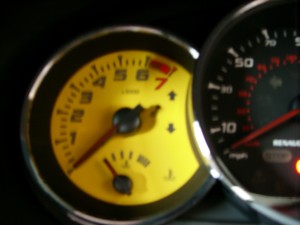 yellow. That’s rule number one of being a hot-hatch, the louder your paint the better! This rather sleek two door terror growls at other cars in the car park like your Nan does over the last pork chop. It really does tick all the boxes in the looks department with its centred exhaust and sporty diffuser. Its racing trinkets continue on the inside with bulging gear knob and bright yellow rev-counter. As if it doesn’t excite the boys from Essex enough it also comes with bolstered racing seats!
yellow. That’s rule number one of being a hot-hatch, the louder your paint the better! This rather sleek two door terror growls at other cars in the car park like your Nan does over the last pork chop. It really does tick all the boxes in the looks department with its centred exhaust and sporty diffuser. Its racing trinkets continue on the inside with bulging gear knob and bright yellow rev-counter. As if it doesn’t excite the boys from Essex enough it also comes with bolstered racing seats!
Ok, so it has the looks to take on the bad boys, but what about the numbers? Rule number two, the bigger the better. Our test car had a two litre turbocharged engine producing 247BHP, which is great but it’s not RS rivalling as it has a 2.5 litre turbocharged engine with 305BHP. As a result 0-60mph in the Megane is 6.1 seconds and the Focus 5.9. However, rule number three of being a hot-hatch is price, it must be cheap or else you may as well go and buy that sports car. Now this is where the Renault claws its way back into the fight, our fully loaded Cup version with all the toys and special racing set-up only costs £21,995.The Focus? £26,995! Don’t get me wrong, the RS is magnificent but it’s no way near £5,000 better than the Cup. In fact the Renault on many levels is more appealing.
It assaults the road with the enthusiasm of a dog let of its lead. The more miles you clock up in this car the better it gets! The cornering is light yet gives plenty of feed back to the driver as it darts from crest to crest. Those previously mentioned bolstered seats aren’t just for display either as they do a fine job of keeping you in the seat as this nimble car does its thing. It feels blisteringly quick with good levels of grip throughout the gear range. But the Renaults hidden talent is that after you finish scorching the tyres and revving it to hell and back it will settle down and get on with taking you to where you want to go. The level of refinement shocked me after experiencing what this car is capable of. It seats four in comfort and all the gizmos just make life that little bit sweeter.
What would I buy? I honestly couldn’t tell you. If they were parked side-by-side I may reach for the Magane’s keys. The only downside of this generally biblical hot-hatch is rear visibility. But in truth, why do you need to see who’s behind you when after overtaking them you’re already in the next county!
 We have been told for quite some time now that electric cars are the future of motoring and the saviour of the polar ice cubes. But just how many electric cars have you seen on the road? One? Maybe three? The Nissan LEAF made a promising start to the mass market of the electric car sector, but there are two big drawbacks that outweigh an electric cars advantages. Firstly there is an issue with range anxiety, and then there is the price. Renault feel they have something that can step up to mark and become the leading electric car model.
We have been told for quite some time now that electric cars are the future of motoring and the saviour of the polar ice cubes. But just how many electric cars have you seen on the road? One? Maybe three? The Nissan LEAF made a promising start to the mass market of the electric car sector, but there are two big drawbacks that outweigh an electric cars advantages. Firstly there is an issue with range anxiety, and then there is the price. Renault feel they have something that can step up to mark and become the leading electric car model.




